All about electric car batteries
Learn about electric car batteries, how they work and how they're recycled.
How do electric car batteries work?
Where internal combustion engined cars get energy from burning petrol or diesel, an electric vehicle gets its power directly from a big pack of batteries.
These are much like a scaled up version of the lithium-ion (Li-ion) battery in your mobile phone - EVs don't use a single battery like a phone, they use instead a pack which is comprised of thousands of individual Li-ion cells working together. When the car's charging up, electricity is used to make chemical changes inside its batteries. When it's on the road, these changes are reversed to produce electricity.
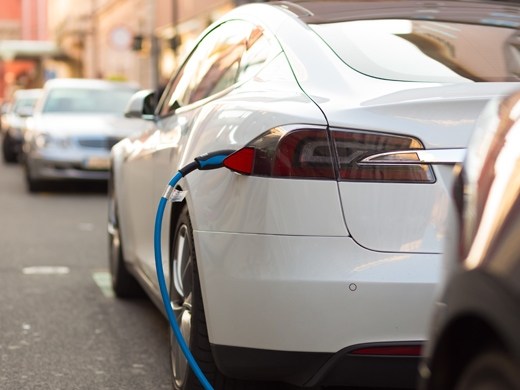
Electric car battery technology
EV batteries undergo cycles of 'discharge' that occur when driving and 'charge' when the car's plugged in. Repeating this process over time affects the amount of charge the battery can hold. This decreases the range and time needed between each journey to charge. Most manufacturers have a five to eight-year warranty on their battery. However, the current prediction is that an electric car battery will last from 10 – 20 years before they need to be replaced.
How a battery and the car's electric motor work together is surprisingly simple – the battery connects to one or more electric motors, which drive the wheels. When you press the accelerator the car instantly feeds power to the motor, which gradually consumes the energy stored in the batteries.
Electric motors also work as generators, so when you take your foot off the throttle the car begins to slow down by converting its forward motion back into electricity – this happens more strongly if you hit the brakes. This regenerative braking recovers energy that would otherwise be lost, storing it in the battery again and so improving the car's range.
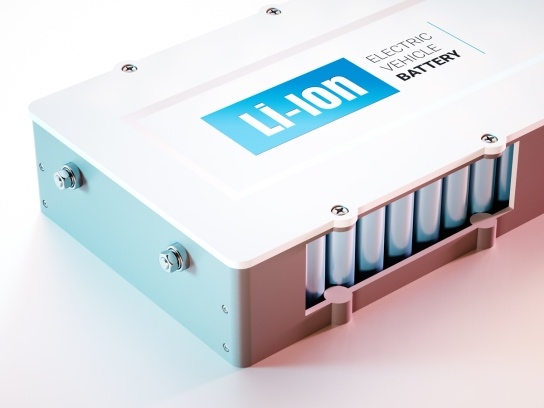
Electric car battery lithium-ion
A Lithium-ion (Li-ion) battery is a type of rechargeable battery used in electric vehicles and a number of portable electronics. They have a higher energy density than typical lead-acid or nickel-cadmium rechargeable batteries. This means that battery manufacturers can save space, reducing the overall size of the battery pack.
Lithium is also the lightest of all metals. However, lithium-ion (Li-ion) batteries contain no lithium metal, they contain ions. For those wondering what an ion is, an ion is a an atom or molecule with an electric charge caused by the loss or gain of one or more electrons.
Lithium-ion batteries are also safer than many alternatives and battery manufacturers have to ensure that safety measures are in place to protect consumers in the unlikely event of a battery failure. For instance, manufacturers equip electric vehicles with charging safeguards to protect the batteries during repeated rapid charging sessions in a short period of time.
Battery capacity explained
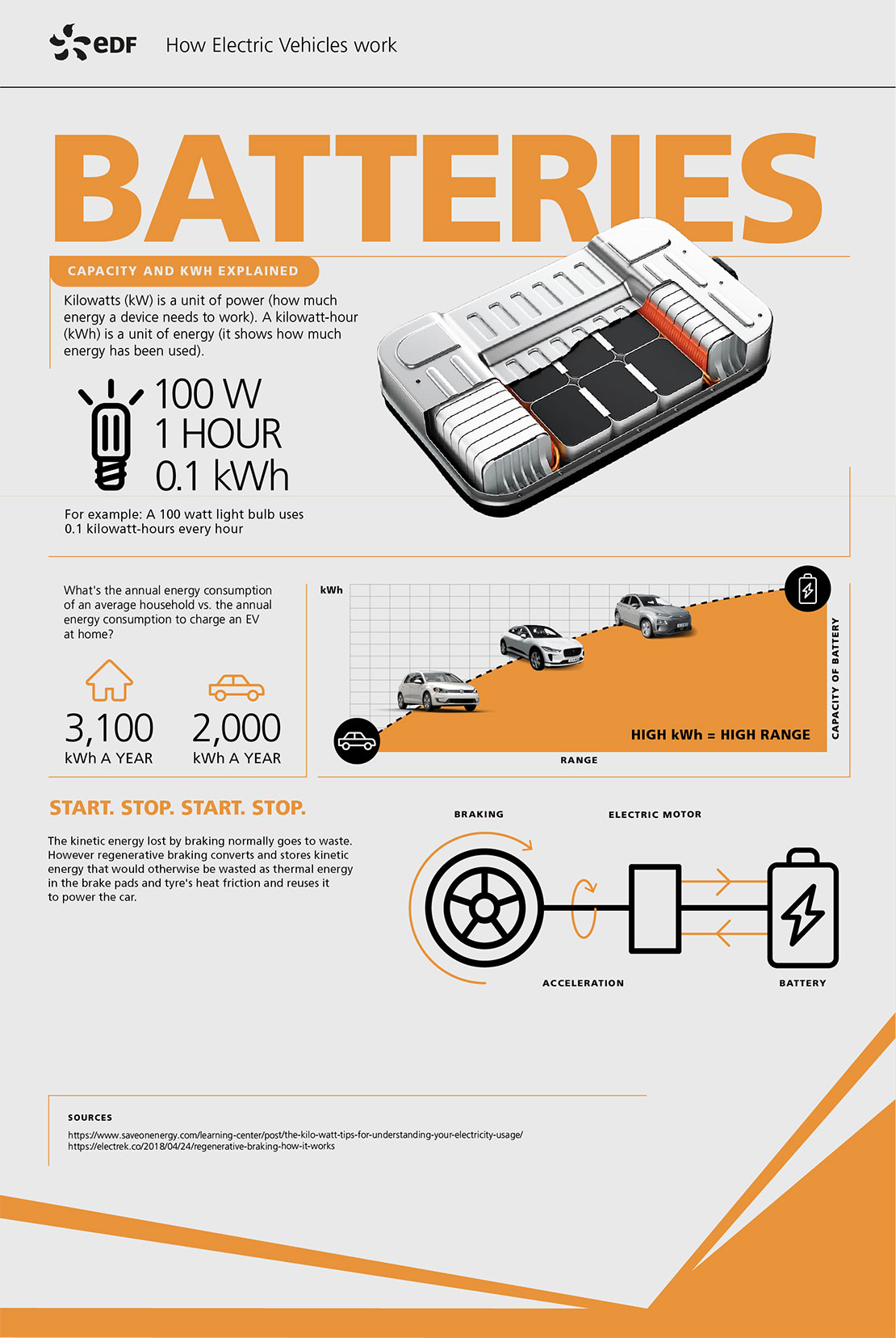
Can't see the infographic image? Read it here
Batteries
Capacity and kWh explained
[IMAGE: example of an EV battery]
Kilowatts (kW) is a unit of power (how much energy a device needs to work). A kilowatt-hour(kWh) is a unit of energy (it shows how much energy has been used)
For example: A 100-watt lightbulb uses 0.1 kilowatt-hours each hour
What's the annual energy consumption of an average household vs. the annual energy consumption to charge an EV at home?
Home: 3,100 kWh a year
Electric car: 2,000 kWh a year
[IMAGE: diagram showing range vs kWh/capacity of a battery, with car examples plotted. We show high kWh = high range]
Start. Stop. Start. Stop.
The kinetic energy caused by braking usually goes to waste. However, regenerative braking converts and stores thermal energy from brake pads and tyre's heat friction and reuses it to power the car.
[IMAGE: diagram showing this visually]
Electric car battery life

Once an EV battery loses its capacity to power a vehicle, it can be used to power a home or building by contributing to a battery storage system. A battery energy storage system stores energy from batteries that can be used at a later time.
If you power your home with renewable energy such as wind or solar, you can also pair it with an EV battery. You can store it up to use throughout the night when wind and sunlight are reduced. Or even during the day alongside solar or wind energy. This method of generating energy can help you save on bills and reduce the amount of energy you use from the grid.
The battery on an electric car is a proven technology that will last for many years. In fact, EV manufacturers guarantee it. Nissan warrants that its electric car batteries will last eight years or 100,000 miles, for example and Tesla offers a similar guarantee.
This might seem remarkable when the battery in your mobile phone begins to wear out after only a couple of years, but during that time it might be fully charged and discharged hundreds of times. Each of these so-called charge cycles counts against the life of the battery: after perhaps 500 full cycles, a lithium-ion phone battery begins to lose a significant part of the capacity it had when new.
While that might be OK in a phone, it's not good enough for a car designed to last many thousands of miles, so EV manufacturers go to great lengths to make electric car batteries last longer. In an EV, batteries are 'buffered', meaning that drivers can't use the full amount of power they store, reducing the number of cycles the battery goes through. Together with other techniques such as clever cooling systems, this means that electric car batteries should give many years of trouble-free life.
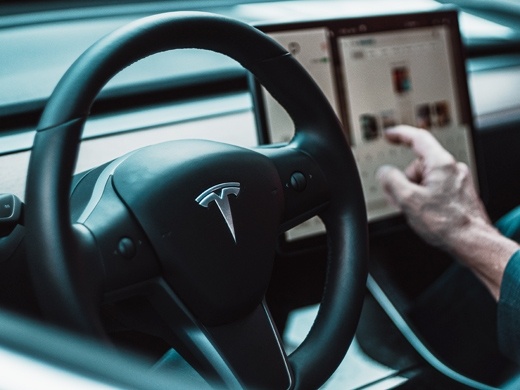
In fact, in order to preserve the life of an electric vehicle battery, manufacturers ensure that there is additional spare capacity to compensate for degradation over time. So as an electric vehicle ages and the battery cycles, the additional spare capacity is used up. This allows the range of the vehicle to stay the same throughout the life of the battery. Once the battery capacity falls below 80%, drivers may start to notice a fall in the range and performance of the battery.
Electric car battery replacement cost
When it comes to replacing an electric vehicle battery, you need not be too concerned as many manufacturers provide a warranty of up to 8 years or 100,000 miles. Meaning that even if you did need to replace it in an unfortunate event that something did go wrong, then it could well be covered under this warranty. Remember to always check the type of warranty offered by your chosen electric car manufacturer.
Also, the cost of batteries fell about 80% between 2010 and 2016 according to McKinsey, from $1000 to $227/kWh. Therefore, a new 40kWh battery in 2016 would have cost just shy of £10,000. Some predictions estimate that prices are set to fall below $100/kWh by 2030, around the same time as the government are aiming for 50% of all new vehicles sold in the UK will be electric.

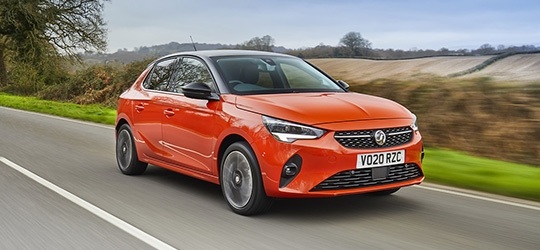
Lease a brand new electric car
Drive a brand new zero-emissions EV with an affordable monthly rental. You'll also have no vehicle tax, low maintenance costs, and a choice of free parking in many convenient locations.
Electric car battery recycling
Many manufacturers are researching how EV batteries can be repurposed once they've hit retirement age. One idea that's proving to work well is repurposing EV batteries to power homes and buildings. However, there are no definitive answers as to what will happen to EV batteries once they’re no longer recyclable.
The time that batteries spend in an EV is often just the beginning of their useful life. Once removed from a car, most batteries will still be fit for other demanding jobs like energy storage in the electricity network, or in the home – a growing area of demand.
When batteries do reach the end of their working life, they'll be recycled, which typically involves separating out valuable materials such as cobalt and lithium salts, stainless steel, copper, aluminium and plastic. At the moment, only about half of the materials in an EV battery pack are recycled, but with EVs expected to undergo an explosion in popularity over the next decade or so, car manufacturers are looking to improve this.
VW recently announced a pilot plant for battery recycling which will work towards a target of recycling 97% of battery components. In this process, batteries will be shredded, dried, then sieved to recover valuable materials that can be used to make new batteries.
Electric car batteries environmental impact
Are electric car batteries bad for the environment? Well, we're here to tell you that the future of EV batteries looks bright.
EV batteries can be fed back into the energy cycle for factories, and homes once its life powering a car has come to an end. Repurposing EV batteries could create a closed-loop system for recycling. Meaning that the factories that produce the batteries could eventually be powered using the repurposed batteries once their lives powering vehicles comes to an end.
Large car manufacturers have already begun to repurpose EV batteries in other areas. For example, Nissan plans to use retired EV batteries to provide back-up power to the Amsterdam ArenA – the world-famous entertainment venue and home to Ajax Football Club.
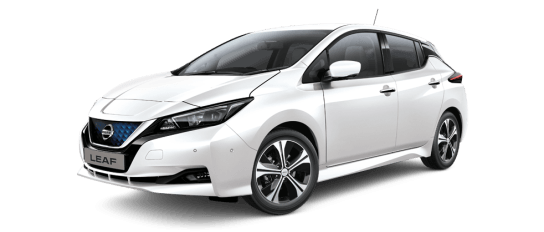
Toyota also plans to install retired batteries outside convenience stores in Japan in the near future. The batteries will be used to store power generated from solar panels. The energy stored will then be used to support the power of drink fridges, food warmers and fresh food counters inside stores.
Renault also announced that the EV batteries from the Renault Zoe EV will be repurposed to generate power to the Powervault - a home energy battery storage system.
With more of these opportunities arising, there will clearly be life beyond an EV. Once a battery has finished powering an electric vehicle, it can be used to power our homes and businesses.
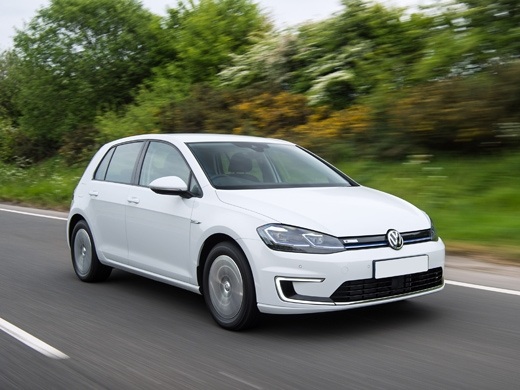
Electric car battery disposal
So what happens when electric car batteries die? Batteries of all forms can prove difficult to dispose of without harming the environment. The same goes for EV batteries. However, EV battery life cycle management works towards solving expensive and toxic disposal of the batteries.
As well as being used to support the use of renewable energy, EV batteries can be refurbished to help power more vehicles in the future. Volkswagen Group has plans to start a recycling project that will see batteries assessed on their quality to determine their future. The batteries with some power left will be given a second life as power packs for mobile vehicle charging. The others that have little to give, will be ground down to a fine powder to extract raw materials such as lithium, nickel, manganese and lithium. The materials can then be rebuilt into more EV batteries.
Electric car battery manufacturers
There are a large number of electric car battery manufacturers. Some are well known such as Tesla and Nissan, while others such as BYD or LG Chem, may not be as well-known around the world, but are nevertheless, significant players in the electric car battery manufacturing space. LG Chem, for instance, supply electric vehicle batteries for the likes of Volvo, Renault, Ford and Chevrolet. Not only that, but they have also signed an agreement with Telsa to supply all Telsa produced in China with batteries.
Another major electric vehicle manufacturer BYD is China's largest electric vehicle manufacturer more than doubled its sales in December 2020 compared to the same time in 2019 and have been selling more battery-powered vehicles since the beginning of 2019. Not only are these battery manufacturers focusing on electric vehicles, but they are also working on battery storage of electricity for residential, commercial and industrial applications.
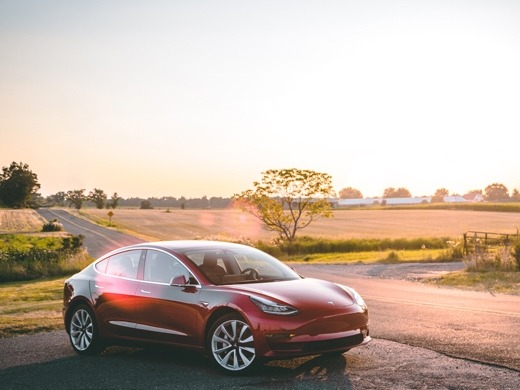
Electric car battery charging
How far can one charge go?
Just as conventional cars have big or small fuel tanks, lithium-ion batteries for electric cars come in different sizes. Rather than litres of fuel, their capacity is measured in kilowatt hours (kWh). A typical 40kWh battery pack from a mainstream electric car might be enough to power it for 150 miles or more, while Tesla's biggest 100kWh battery is good for 375 miles according to the WLTP standard - which aims to give a realistic estimation of cars' real-world range or fuel economy.
WLTP is an abreviation of the Worldwide Harmonised Light Vehicle Test Procedure, which came in to effect in 2017 and was set up to measure fuel consumption,CO2 levels and other pollutant emissions from passenger cars. It replaced the New European Driving Cycle (NEDC)
You might recognise the kilowatt hour from your electricity bill – it's the industry standard charging unit. A 40kWh battery holds enough energy to power a typical home for four days!
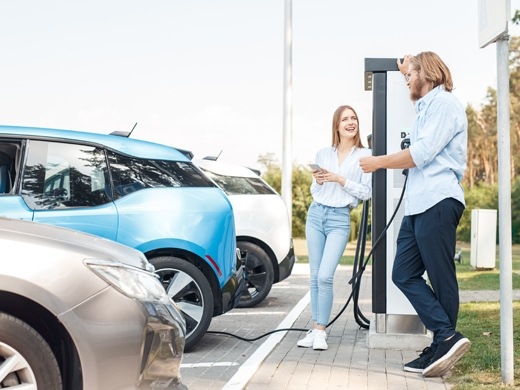
How do you recharge an electric car battery?
You'll get the fastest charge from a designated EV charging socket. These are rated in kW from about 3kW up to about 50kW - or 120kW on Tesla's supercharger network. The higher the rating, the quicker they'll restore your EV's range.
The chargers most commonly fitted at a home or workplace are either 3kW 'slow' units, or 7kW 'fast' chargers capable of recharging an EV in 6-12 hours. The UK also has a growing network of public charging stations. These are typically either fast chargers rated at up to 22kW, or 'rapid' chargers capable of delivering up to 50kW. The fastest public charging stations can top an EV up to 80% of its range in as little as an hour – the last 20% is usually a bit slower, to prevent damage to the batteries as they get near to full charge.
Where no designated charging point is available, you can charge an electric car from a 13-amp domestic plug socket, but this can be very slow. Because charging demands lots of power over a long period there may also be a risk of overheating or fire, so if you must do this you should have an electrician inspect the socket and wiring first.
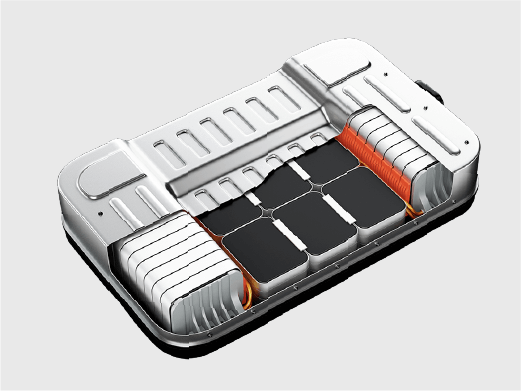
How safe are electric car batteries?
The manufacturers of batteries for electric cars go to great lengths to make sure EV batteries are safe, fitting smart management systems to prevent overheating and other problems. Batteries do get warm as they charge and discharge, but cars are designed to keep them cool – high performance EVs sometimes have liquid cooling systems to help.
Despite this, there have been some cases of electric cars catching fire, but very few of these incidents have been caused by battery failures. More typically they've resulted from accidents or incidents that might have caused any vehicle to catch fire - such as the 2013 case of a Tesla Model S which hit a large piece of metal at high speed. Commenting on that incident, which resulted in a limited fire, Tesla CEO Elon Musk pointed out that EV batteries contain only about a tenth of the energy of a tank full of fuel, limiting the danger they pose in an accident.
In fact, a 2017 study by the US National Highway Traffic Safety Administration found that the likelihood and severity of fires from lithium-ion batteries was comparable to, or slightly less than that from conventional vehicles. As more electric vehicles take to the roads, we can be increasingly sure they're as safe as the conventional cars they replace.
Learn more about electric cars
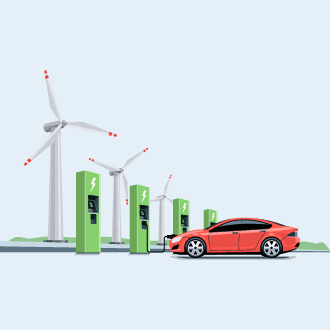
Electric cars and the environment
Find out how electric cars are better for the environment.
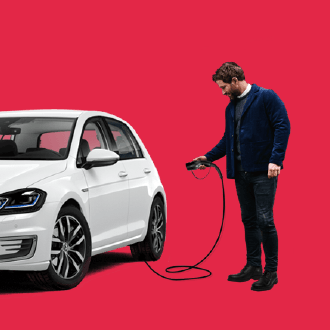
EV charging options: when, where & how
Learn about all the different options for charging your electric car on the go and at home.

Running costs of an electric car
Find out what it costs to buy and run an electric car.